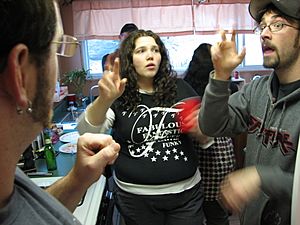Language facts for kids

Language is the normal way humans communicate. Only humans use language, though many other animals communicate in various ways.
Human language has syntax, a set of rules for connecting words together to make statements and questions. Language can also be changed, by adding new words, for example, to describe new things. Other animals may inherit a set of calls which have pre-set functions.
Language may be done by speech or by writing or by moving the hands to make signs. It follows that language is not just any way of communicating. Even some human communication is not language: see non-verbal communication. Humans also use language for thinking.
Language is a word that may be used by extension:
- The language of a community or country.
- The ability of speech.
- Formal language in mathematics, logic and computing.
- Sign language for deaf people (people who cannot hear).
- A type of school subject.
UNESCO says that 2,500 languages are at risk of becoming extinct.
Contents
Universals of language
All languages share certain things which separate them from all other kinds of communication.
- A language has rules which are shared by a community.
- All human languages are based on sound and hearing, or in the case of sign language, vision. All the basic sound units, or phonemes, have this in common: they can be spoken by the human voice, and heard by the human ear.
- The sounds come out in a sequence, not all at once. This is mimicked in writing, where the marks are put on the paper or screen in the same sequence.
- The stream of sounds have little gaps between them, and come in bigger packages. We call the bigger packets sentences or questions or replies or comments.
- In most languages, English being one, the syntax or order of the words can change the meaning: "the cat sat on the man" is different from "the man sat on the cat".
- Words (which may be made up of more than one phoneme) divide up into two classes: content and non-content. Content words have meaning: nouns, verbs, adjectives, etc. Non-content words are there to make the language work: and, not, in, out, what, etc. Grammar consists of studying how words fit together to mean something.
- All languages have:
- sentences with two types of expression: nouns and verbs: Jill is here.
- adjectives to modify nouns: good food.
- ways of linking: sink or swim.
- dummy elements: Jill likes to swim, so do I.
- devices to order or ask questions: Get up! Are you ill?
- Most of the languages have a written form. Before the invention of audio recording, the writing system was the only way to keep track of spoken information.
- All languages constantly evolve. New words appear, new form of saying things, new accents.
There are many more things in common between languages.
Inheritance
The capacity to learn and use language is inherited. Normally, all humans are born with this capability. Which language is learned by a child depends on which language is spoken by the child's community. The capacity is inherited, but the particular language is learned.
Children have a special period, from about 18 months to about four years, which is critical for learning the language. If this is seriously disrupted, then their language skills will be damaged. Older people learn differently, so they seldom learn a second language as well as they learn their native language.
Types of language

Mathematics and computer science use created languages called formal languages (like computer programming languages), but these may or may not be 'true' languages. Mathematics itself is seen as a language by many. Some people consider musical notation to be a way of writing the musical language.
Chinese is the language with the most native speakers in the world, but Chinese is not really a language. It is a close family of dialects, some of which are as different as Romance languages are from one another.
English is often called "the international language",or the world's lingua franca. It is the main second language of the world and the international language of science, travel, technology, business, diplomacy, and entertainment.
-
- English as a first language: 380 million.p108
- English as an official second language: up to 300 million.
- English taught as a second language, but with no official status: anyone's guess, up to 1000 million/1 billion.
- Chinese (Mandarin): 390 million native speakers.p96
Some languages are made up so that a lot of people around the world can learn them, without the new languages being tied to any specific country or place. These are called constructed languages. One of the most popular of these languages is Esperanto, which is sometimes called "La Internacia Lingvo," or "The International Language." Another of these languages is called Volapuk, which was popular about a hundred years ago but is much less popular now. It has mostly been replaced by languages like Esperanto, Interlingua, and Ido.
Part of the reason that Volapuk became unpopular is that some sounds are hard to say for people who speak Spanish or English, two of the most widely spoken languages in the world.
Related pages

- Alphabet
- Basic English
- English as a foreign language
- English language
- Historical linguistics
- Language families and languages
- Linguistics
- List of languages
- Orthography
- Phonology
- Second language
- Semantics
- Sign language
Images for kids
-
William Jones discovered the family relation between Latin and Sanskrit, laying the ground for the discipline of historical linguistics.
-
Ferdinand de Saussure developed the structuralist approach to studying language.
-
Noam Chomsky is one of the most important linguistic theorists of the 20th century.
-
A lesson at Kituwah Academy, a school where English and the Cherokee language are mediums of instruction
-
An inscription of Swampy Cree using Canadian Aboriginal syllabics, an abugida developed by Christian missionaries for Indigenous Canadian languages
-
The first page of the poem Beowulf, written in Old English in the early medieval period (800–1100 AD). Although Old English is the direct ancestor of modern English, it is unintelligible to contemporary English speakers.
See also
 In Spanish: Lenguaje para niños
In Spanish: Lenguaje para niños











